Animals in India, With over 350 species of mammals and well over 1000 species of birds protected in over a hundred national parks, India is a fascinating and magical destination, primarily for its amazing culture, but still incredibly rewarding for the animal lover. The highlights for them are many: whether stalking tigers in the dense jungle, photographing snow leopards from afar or encountering a cute red panda on foot. Although more sparse than the wildlife in Africa, the country offers some exciting wildlife encounters that combine perfectly with its vibrant culture.
The country’s habitats range with Animals in India from the towering peaks of the Himalayas to the forests, lakes and steaming backwaters of Kerala in the south, creating a unique wealth of biodiversity that is sure to delight any animal lover.
Almost all visitors come here for the Bengal tiger, but other very special species such as the snow leopard, Asiatic lion, Asiatic elephant, Indian rhinoceros, sloth bear and red panda also live here. For all of these species you will find specially designed safaris that focus on observing them in the wild.

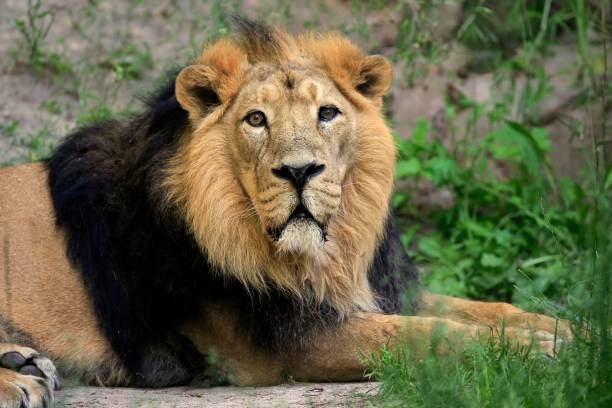
As a subspecies of lion, the Asiatic lion is also known as the Indian lion or Persian lion. Originally widespread throughout Asia, it is now only found in the wild in the Indian state of Gujrat in the Gir National Park.
The Asiatic lion is slightly smaller than the lion that lives in Africa, but is otherwise very similar to it. The packs are slightly smaller, so the female lions in the Gir National Park live together in groups of two to six individuals and their young.
During the colonial period, lions were heavily hunted and almost wiped out, in 1913 there were only 20 individuals. With the ban on lion hunting by the Indian government in 1955 and the establishment of the Gir National Park ten years later, the population was able to grow steadily. Today, the Asiatic lion population is estimated at 250 to 300 specimens, making it on the Red List of endangered species.
Gir National Park is one of the smaller national parks, with a core area of 258 km² and a total area of 1153 km², and is very well visited due to the Asiatic lions that live here. The safaris offered are carried out on fixed routes and with a set time limit, early planning is recommended. You also need a bit of luck to see lions there.


Once widespread throughout Asia, tigers now only live on the Indian subcontinent and in remote regions of Southeast Asia, in the Russian Far East with adjacent parts of northern China, and on the island of Sumatra. The tiger’s habitats are tropical rainforests, swamps, grasslands or boreal forests. The tiger is a loner and feeds mainly on larger ungulates.
Young animals stay with their mother for up to three years, so they are often found together. Tigers are nocturnal hunters, but they are also active at dusk and occasionally hunt during the day. They can cover very long distances in search of prey. Unlike other big cats, tigers are excellent swimmers and like to go into the water. Due to their size, tigers are poor climbers and only climb large trees in an emergency.
With hunting during the colonial period, the tiger population declined sharply. Today, the destruction of habitats through deforestation, illegal hunting and the prohibited trade in tiger products on the black market, represent a continuing threat to tigers. With increasing population pressure in Animals in India and the expansion of cities, the tigers’ available territories are increasingly shrinking and they are having to move to areas outside the protected areas, where they are hunted as a threat to humans and domestic animals. It is estimated that there are currently 3,000 to 5,000 wild tigers, most of which live in isolated protected areas. Tigers are therefore classified as “critically endangered”.
In central India, Tadoba National Park is the oldest and largest national park and the most suitable park for tiger watching. Overall, the national parks of Animals in India are much smaller and more visited than the parks in Africa, creating a different safari feeling. Permits are issued on a personal basis and only for certain routes, with the best routes also being the most expensive.
Located in the state of Madhya Pradesh in central India, Kanha National Park is one of the most famous parks in India and is home to a high level of animal diversity. The park has a good tiger population and is one of the places with the highest probability of seeing tigers in the wild.

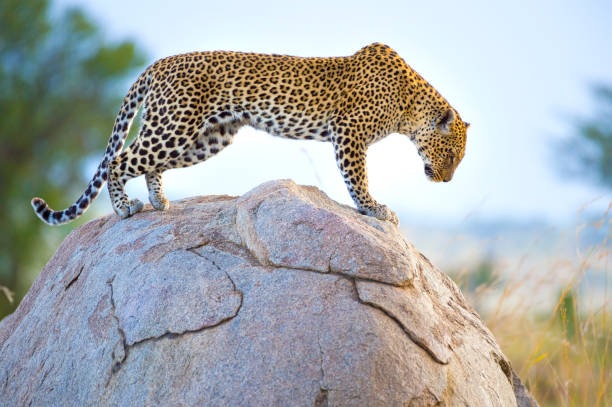
As a very adaptable animal, the Asian leopard is widespread overall, but it is not found in every Asian country. In Asia, it lives in coniferous forests along the Amur River as well as in the tropics in India and Southeast Asia. There are no differences in hunting behavior or physiognomy to the African leopard.
A large number of Asian leopards live in the Nagarhole National Park in southern India, and their only enemies are a few tigers. In the state of Rajasthan, a considerable number of leopards live in the Bera Conservation Area. In this relatively isolated area with a large number of small villages, the leopards can be seen on the surrounding rocks that characterize this region. Watching the leopards climbing the rocks is just as fantastic as the photos that result.

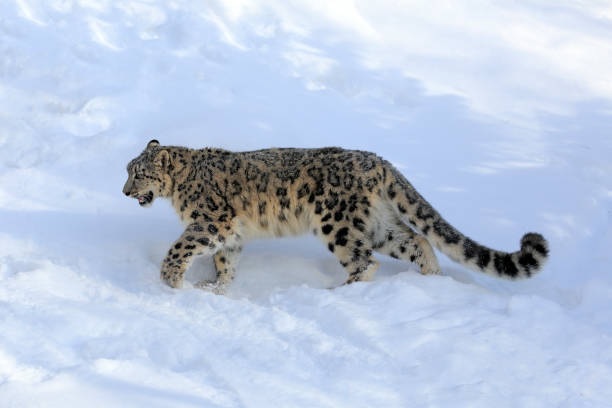
The snow leopard lives in the high mountains of Central Asia, it is found in the Himalayas as well as in the Altai and Sayan Mountains in Russia and in the Tibetan highlands as far as the Pamir and Hindu Kush.
It is similar to leopards, but has a longer and mostly grey coat, which is particularly thick in winter. The snow leopard is easily distinguishable from other big cat species due to its extremely long tail and relatively short snout. Unlike other big cats, the snow leopard never roars. The very large paws are covered with a hair pad on the soles, which increases the surface area and thus protects against the cold and reduces sinking into snow fields.
The snow leopard can be found in rocky and rugged mountain regions up to an altitude of 6000 meters, where it lives as a loner. As a hunter, it feeds mainly on medium-sized hoofed animals such as wild sheep and rodents. Like the tiger, the snow leopard is also poached because it is believed to have magical powers in traditional Chinese medicine. The snow leopard is also considered endangered due to the decline in the number of prey animals.
The Hemis National Park in Ladakh is the largest contiguous nature reserve in Southeast Asia at 4,100 km² and lies at an altitude of around 3,500 meters. Around 200 snow leopards live here. In the winter months, especially from January to March, the snow leopards follow their prey into the lower regions. Then there is a good chance of seeing these legendary and shy big cats with the help of trackers and possibly even observing them from a distance for a longer period of time.
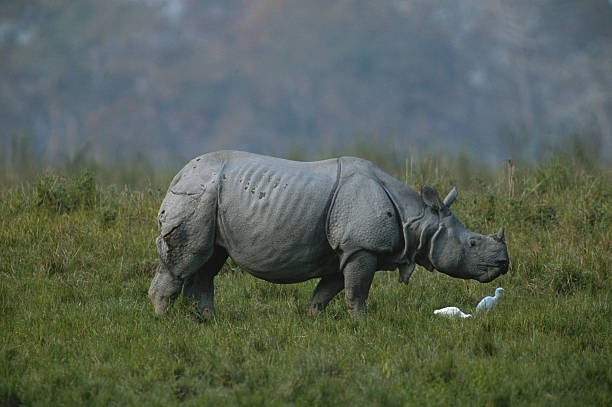
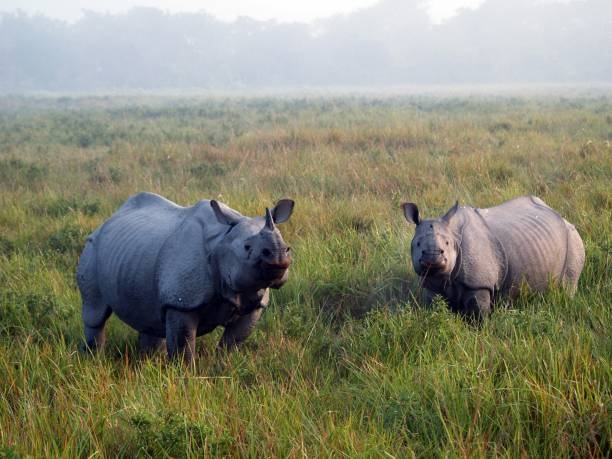
The Sumatran rhinoceros is the subspecies with the most hair, and its second horn makes it slightly different from the other two Asian rhinoceros species, the Javan and Indian rhinoceros. This subspecies is in acute danger of extinction, and survival seems only possible with the help of breeding programs. Today, only about 100 Sumatran rhinos live in the wild.
The WWF has been fighting against poaching of the Javan rhinoceros on Java since the 1960s. Here, too, the survival of the species is to be saved by means of breeding stations. There are still 60 individuals of this species living on Java.
The Indian rhinoceros is the largest of the three Asian rhinoceros species, with about 2,750 still living in the wild. Today, its habitat is limited mainly to the Indian states of West Bengal and Assam. Here, the rhinos can be observed on game drives in Kaziranga National Park, although the number of tourists here is very high. Only a few tourists find their way to Manas National Park at the foot of the Himalayas, but you also need a lot of luck to see a rhinoceros.


The Asian elephants are slightly smaller than their relatives in Africa. They can be recognized by their significantly smaller ears, arched back, smoother skin and the tip of the trunk, which has a small finger for grasping.
There are three subspecies: the Sri Lankan elephant, which lives in Sri Lanka, the Sumatran elephant, which is native to Sumatra and Borneo, and the Indian elephant, which lives on the Asian mainland.
The Borneo pygmy elephant is another subspecies, which lives in the north of Borneo. The Asian elephant is often tamed and used as a working animal. Like the African elephant, it is also threatened by poaching and loss of habitat.
Wild specimens of the Asian elephant can be observed in Corbett National Park in the Indian state of Uttarakhand at the foot of the Himalayas.
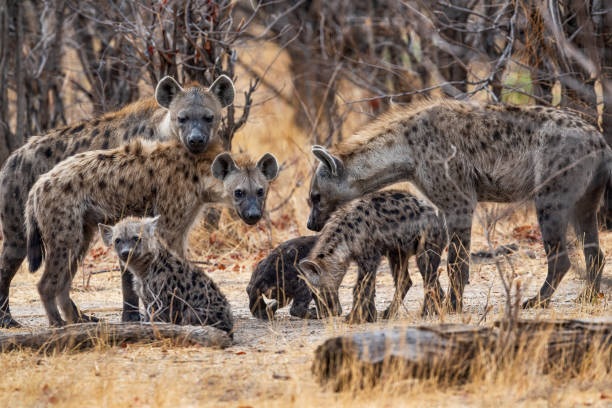
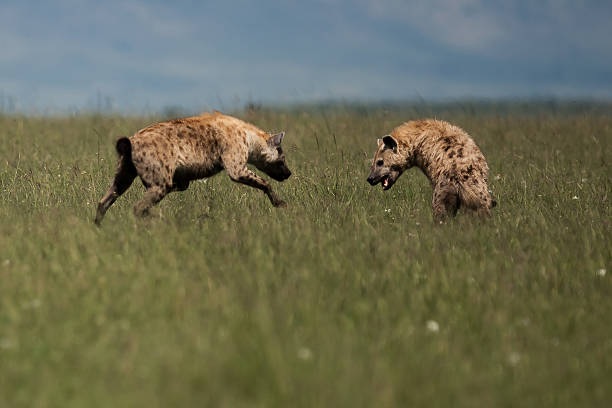
These predators live in large parts of Africa, with the exception of the desert areas of the Sahara and the Congo Basin, and you can certainly come across them on a safari. A special feature of these mammals is the seemingly constant smile on their faces, while the overall impression of the animal, which is reminiscent of a dog, is not necessarily one of beauty.
The spotted hyena, the brown hyena and the striped hyena are distinguished, with the spotted hyena being the largest and most numerous subspecies. Their rivalry with the lion is spectacular and is the subject of many animal films. The aardwolf is the smallest species of hyena and its diet of termites also differs significantly from the other hyenas. All species of hyena are active at night, but the spotted hyenas also hunt during the day when the sky is cloudy.
Hyenas have light to dark brown fur and, weighing just under 60 kilograms, a very strong build. South of the Sahara, you are most likely to come across the spotted hyena, which, unlike the others, feeds mainly through active hunting. They usually kill larger ungulates such as antelopes, gazelles, zebras or wildebeest and hunt individually or in groups, with their most important tool being endurance. But carrion or prey stolen from other carnivores is also on the menu.
Hyenas play an important role in mystical African tales. On the one hand, they are dangerous and cruel animals, but on the other hand, they are a symbol of strength and endurance and are even considered sacred animals. The Tabwa of East Africa have a myth that a spotted hyena brought the sun and thus warmed the earth. Other peoples use hyena masks to pass on their positive characteristics and abilities to the wearer.
Since hyenas often invade herds of cattle and kill domestic animals, hunting by humans is one of the greatest threats. The destruction of habitat and the decline in prey animals are also problematic. With the exception of the aardwolf, all hyena species are declining in population.


Sloth bears are predators from the bear family that are native to South Asia. They have some features, especially on their faces, that distinguish them from all other bears. Their hairless lips are elongated, extremely flexible and can be extended. Their narrow tongue is also elongated and can be extended far out. All of these features are adaptations to the sloth bear’s diet, which consists mainly of insects, with termites being the main ingredient. The bears tear open the termite mounds with their powerful claws, blow the dust away and then stick their snouts in.
The termites are sucked out like with a vacum cleaner or licked up with their long tongue. Depending on the season, fruit also makes up a large part of their diet. Like all bears, they are loners. Sloth bears are mostly nocturnal, and during the day they often stay in caves. They do not hibernate, but are quite inactive during the rainy season.
If there is such a thing as a best place to see sloth bears, it is undoubtedly Satpura National Park in the state of Madhya Pradesh in central India.
What this rarely visited national park lacks – tigers and tourists – it makes up for with an attraction of the more impressive kind. The star of the incredibly scenic park are the scruffy-looking sloth bears, which are relatively easy to spot – even on foot! Many visitors to Satpura have fond childhood memories of The Jungle Book and come here to see the living model for Baloo.
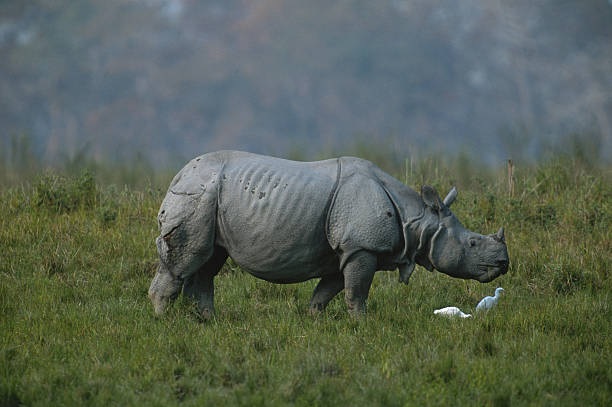

The Indian rhinoceros is the largest of the three Asian rhinoceros species, with around 2,750 still living in the wild today. Today, its habitat is limited mainly to the Indian states of West Bengal and Assam. Here, the rhinos can be observed on game drives in Kaziranga National Park, although the number of tourists is very high. Only a few tourists find their way to Manas National Park at the foot of the Himalayas, but you also need a lot of luck to see a rhinoceros here.
Little can be added to what has already been said about Indian rhinoceros. After tigers, the imposing rhinoceros with its prehistoric appearance takes second place on the list of must-see animal species.
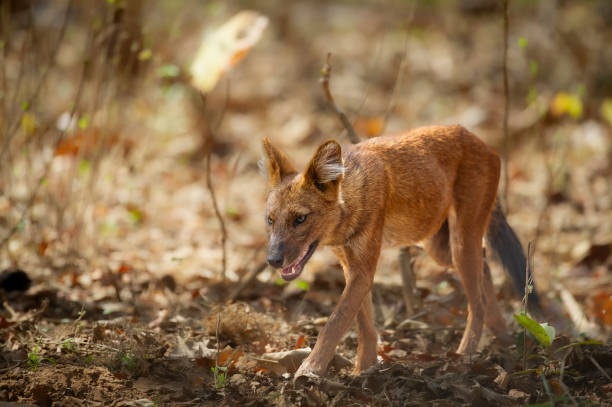
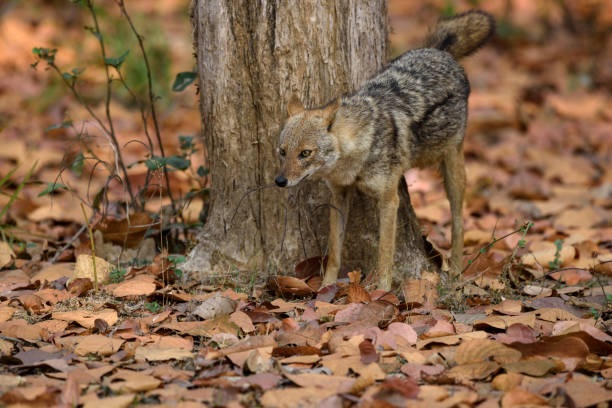
Like all animal species typical of India, wild dogs are seriously threatened by the increasing loss of habitat. Only the larger, consecutive tiger reserves with healthy populations of sambar and axis deer can also support packs of wild dogs.
This applies in particular (but not only) to the parks in central India. The sparse forests and open grasslands of Bandhavgarh, Kanha, Pench and Tadoba, which spread like a string of pearls, offer the wild dogs an ideal, limitless habitat in which the nomadic animals can roam.
In the south of the country, the adjacent parks of Bandipur and Nagarhole in Katarnaka maintain some of the largest dhole packs in India.
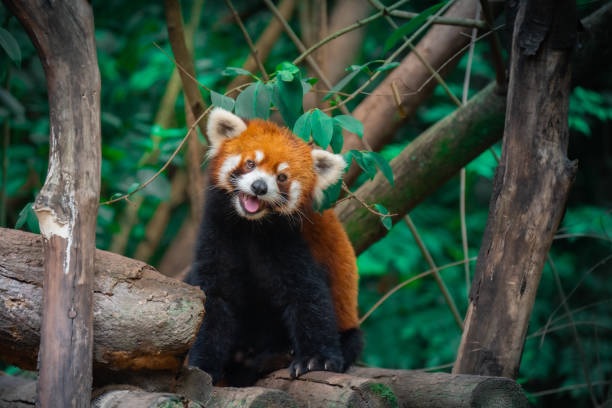

Red pandas are extremely shy, solitary creatures and can only be spotted after persistent work. Multi-day treks are required to maximize the chances.
Visitors usually cast their eyes towards neighboring Nepal when it comes to spotting red pandas in the wild. However, the eastern Himalayan region on the Indian side of the border is also home to relatively large populations of this endangered bear species, which is under severe threat due to habitat loss.
20 protected areas have been established by the government in northeast India to protect red pandas. The most important of these are Khangchendzonga National Park (Sikkim), Neora Valley National Park and especially Singalila National Park (West Bengal).
The eastern Himalayan region has an unusual climate with cold winters from mid-November-February and plenty of rain between March and April and July-September. It is best to plan a trip in the relatively dry months of May-June and October-November.
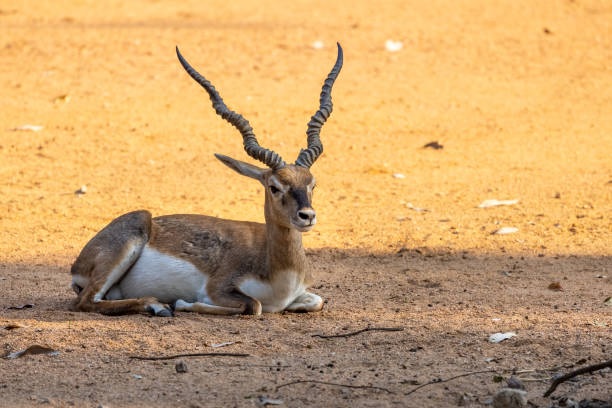
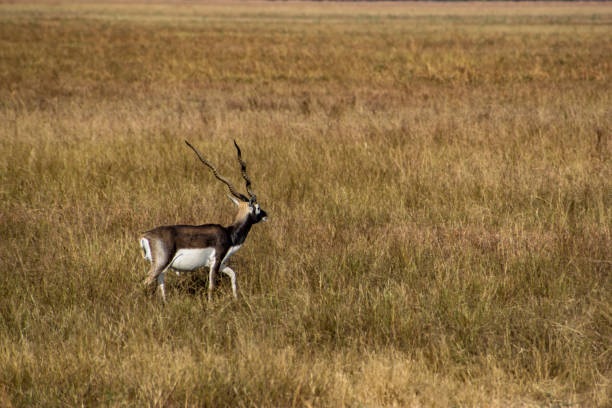
The blackbuck, often better known by its English name blackbuck, is the most famous of all antelope species in the Indian subcontinent. Although not well known outside the country’s borders, it attracts a relatively large number of animal lovers who want to see it. Visitors who visit India several times in particular show interest in the beautiful blackbuck.
The Velavadar National Park in Gujarat and the Ranebennur and Jayamangali wildlife sanctuaries in Katarnaka are home to the largest populations.
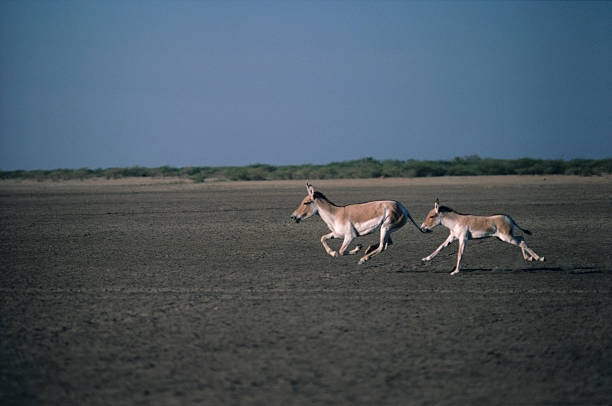
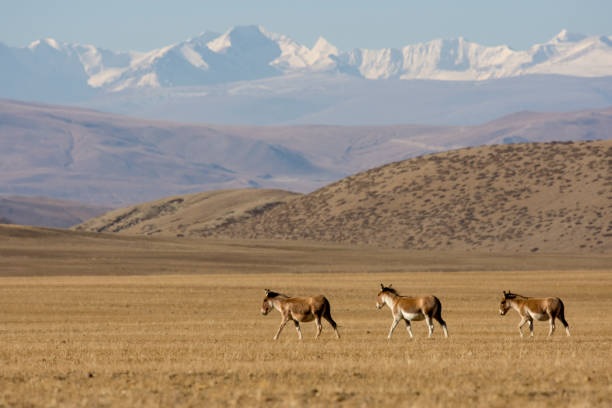
Indian wild asses are found in the swampy area of Little Rann Kutch in the state of Gujarat. You can see them in groups along with a variety of other animals, such as foxes, nilgai and wild boars. In winter, the barren landscape turns into a bird paradise.
Thankyou for reading our blog of Animals in India by Delighted Journey.
Animals in India, With over 350 species of mammals and well over 1000 species of birds protected in over a hundred national parks, India is a fascinating and magical destination, primarily for its amazing culture, but still incredibly rewarding for the animal lover. The highlights for them are many: whether stalking tigers in the dense jungle, photographing snow leopards from afar or encountering a cute red panda on foot. Although more sparse than the wildlife in Africa, the country offers some exciting wildlife encounters that combine perfectly with its vibrant culture.
The country’s habitats range with Animals in India from the towering peaks of the Himalayas to the forests, lakes and steaming backwaters of Kerala in the south, creating a unique wealth of biodiversity that is sure to delight any animal lover.
Almost all visitors come here for the Bengal tiger, but other very special species such as the snow leopard, Asiatic lion, Asiatic elephant, Indian rhinoceros, sloth bear and red panda also live here. For all of these species you will find specially designed safaris that focus on observing them in the wild.


As a subspecies of lion, the Asiatic lion is also known as the Indian lion or Persian lion. Originally widespread throughout Asia, it is now only found in the wild in the Indian state of Gujrat in the Gir National Park.
The Asiatic lion is slightly smaller than the lion that lives in Africa, but is otherwise very similar to it. The packs are slightly smaller, so the female lions in the Gir National Park live together in groups of two to six individuals and their young.
During the colonial period, lions were heavily hunted and almost wiped out, in 1913 there were only 20 individuals. With the ban on lion hunting by the Indian government in 1955 and the establishment of the Gir National Park ten years later, the population was able to grow steadily. Today, the Asiatic lion population is estimated at 250 to 300 specimens, making it on the Red List of endangered species.
Gir National Park is one of the smaller national parks, with a core area of 258 km² and a total area of 1153 km², and is very well visited due to the Asiatic lions that live here. The safaris offered are carried out on fixed routes and with a set time limit, early planning is recommended. You also need a bit of luck to see lions there.


Once widespread throughout Asia, tigers now only live on the Indian subcontinent and in remote regions of Southeast Asia, in the Russian Far East with adjacent parts of northern China, and on the island of Sumatra. The tiger’s habitats are tropical rainforests, swamps, grasslands or boreal forests. The tiger is a loner and feeds mainly on larger ungulates.
Young animals stay with their mother for up to three years, so they are often found together. Tigers are nocturnal hunters, but they are also active at dusk and occasionally hunt during the day. They can cover very long distances in search of prey. Unlike other big cats, tigers are excellent swimmers and like to go into the water. Due to their size, tigers are poor climbers and only climb large trees in an emergency.
With hunting during the colonial period, the tiger population declined sharply. Today, the destruction of habitats through deforestation, illegal hunting and the prohibited trade in tiger products on the black market, represent a continuing threat to tigers. With increasing population pressure in Animals in India and the expansion of cities, the tigers’ available territories are increasingly shrinking and they are having to move to areas outside the protected areas, where they are hunted as a threat to humans and domestic animals. It is estimated that there are currently 3,000 to 5,000 wild tigers, most of which live in isolated protected areas. Tigers are therefore classified as “critically endangered”.
In central India, Tadoba National Park is the oldest and largest national park and the most suitable park for tiger watching. Overall, the national parks of Animals in India are much smaller and more visited than the parks in Africa, creating a different safari feeling. Permits are issued on a personal basis and only for certain routes, with the best routes also being the most expensive.
Located in the state of Madhya Pradesh in central India, Kanha National Park is one of the most famous parks in India and is home to a high level of animal diversity. The park has a good tiger population and is one of the places with the highest probability of seeing tigers in the wild.


As a very adaptable animal, the Asian leopard is widespread overall, but it is not found in every Asian country. In Asia, it lives in coniferous forests along the Amur River as well as in the tropics in India and Southeast Asia. There are no differences in hunting behavior or physiognomy to the African leopard.
A large number of Asian leopards live in the Nagarhole National Park in southern India, and their only enemies are a few tigers. In the state of Rajasthan, a considerable number of leopards live in the Bera Conservation Area. In this relatively isolated area with a large number of small villages, the leopards can be seen on the surrounding rocks that characterize this region. Watching the leopards climbing the rocks is just as fantastic as the photos that result.


The snow leopard lives in the high mountains of Central Asia, it is found in the Himalayas as well as in the Altai and Sayan Mountains in Russia and in the Tibetan highlands as far as the Pamir and Hindu Kush.
It is similar to leopards, but has a longer and mostly grey coat, which is particularly thick in winter. The snow leopard is easily distinguishable from other big cat species due to its extremely long tail and relatively short snout. Unlike other big cats, the snow leopard never roars. The very large paws are covered with a hair pad on the soles, which increases the surface area and thus protects against the cold and reduces sinking into snow fields.
The snow leopard can be found in rocky and rugged mountain regions up to an altitude of 6000 meters, where it lives as a loner. As a hunter, it feeds mainly on medium-sized hoofed animals such as wild sheep and rodents. Like the tiger, the snow leopard is also poached because it is believed to have magical powers in traditional Chinese medicine. The snow leopard is also considered endangered due to the decline in the number of prey animals.
The Hemis National Park in Ladakh is the largest contiguous nature reserve in Southeast Asia at 4,100 km² and lies at an altitude of around 3,500 meters. Around 200 snow leopards live here. In the winter months, especially from January to March, the snow leopards follow their prey into the lower regions. Then there is a good chance of seeing these legendary and shy big cats with the help of trackers and possibly even observing them from a distance for a longer period of time.


The Sumatran rhinoceros is the subspecies with the most hair, and its second horn makes it slightly different from the other two Asian rhinoceros species, the Javan and Indian rhinoceros. This subspecies is in acute danger of extinction, and survival seems only possible with the help of breeding programs. Today, only about 100 Sumatran rhinos live in the wild.
The WWF has been fighting against poaching of the Javan rhinoceros on Java since the 1960s. Here, too, the survival of the species is to be saved by means of breeding stations. There are still 60 individuals of this species living on Java.
The Indian rhinoceros is the largest of the three Asian rhinoceros species, with about 2,750 still living in the wild. Today, its habitat is limited mainly to the Indian states of West Bengal and Assam. Here, the rhinos can be observed on game drives in Kaziranga National Park, although the number of tourists here is very high. Only a few tourists find their way to Manas National Park at the foot of the Himalayas, but you also need a lot of luck to see a rhinoceros.


The Asian elephants are slightly smaller than their relatives in Africa. They can be recognized by their significantly smaller ears, arched back, smoother skin and the tip of the trunk, which has a small finger for grasping.
There are three subspecies: the Sri Lankan elephant, which lives in Sri Lanka, the Sumatran elephant, which is native to Sumatra and Borneo, and the Indian elephant, which lives on the Asian mainland.
The Borneo pygmy elephant is another subspecies, which lives in the north of Borneo. The Asian elephant is often tamed and used as a working animal. Like the African elephant, it is also threatened by poaching and loss of habitat.
Wild specimens of the Asian elephant can be observed in Corbett National Park in the Indian state of Uttarakhand at the foot of the Himalayas.


These predators live in large parts of Africa, with the exception of the desert areas of the Sahara and the Congo Basin, and you can certainly come across them on a safari. A special feature of these mammals is the seemingly constant smile on their faces, while the overall impression of the animal, which is reminiscent of a dog, is not necessarily one of beauty.
The spotted hyena, the brown hyena and the striped hyena are distinguished, with the spotted hyena being the largest and most numerous subspecies. Their rivalry with the lion is spectacular and is the subject of many animal films. The aardwolf is the smallest species of hyena and its diet of termites also differs significantly from the other hyenas. All species of hyena are active at night, but the spotted hyenas also hunt during the day when the sky is cloudy.
Hyenas have light to dark brown fur and, weighing just under 60 kilograms, a very strong build. South of the Sahara, you are most likely to come across the spotted hyena, which, unlike the others, feeds mainly through active hunting. They usually kill larger ungulates such as antelopes, gazelles, zebras or wildebeest and hunt individually or in groups, with their most important tool being endurance. But carrion or prey stolen from other carnivores is also on the menu.
Hyenas play an important role in mystical African tales. On the one hand, they are dangerous and cruel animals, but on the other hand, they are a symbol of strength and endurance and are even considered sacred animals. The Tabwa of East Africa have a myth that a spotted hyena brought the sun and thus warmed the earth. Other peoples use hyena masks to pass on their positive characteristics and abilities to the wearer.
Since hyenas often invade herds of cattle and kill domestic animals, hunting by humans is one of the greatest threats. The destruction of habitat and the decline in prey animals are also problematic. With the exception of the aardwolf, all hyena species are declining in population.


Sloth bears are predators from the bear family that are native to South Asia. They have some features, especially on their faces, that distinguish them from all other bears. Their hairless lips are elongated, extremely flexible and can be extended. Their narrow tongue is also elongated and can be extended far out. All of these features are adaptations to the sloth bear’s diet, which consists mainly of insects, with termites being the main ingredient. The bears tear open the termite mounds with their powerful claws, blow the dust away and then stick their snouts in.
The termites are sucked out like with a vacum cleaner or licked up with their long tongue. Depending on the season, fruit also makes up a large part of their diet. Like all bears, they are loners. Sloth bears are mostly nocturnal, and during the day they often stay in caves. They do not hibernate, but are quite inactive during the rainy season.
If there is such a thing as a best place to see sloth bears, it is undoubtedly Satpura National Park in the state of Madhya Pradesh in central India.
What this rarely visited national park lacks – tigers and tourists – it makes up for with an attraction of the more impressive kind. The star of the incredibly scenic park are the scruffy-looking sloth bears, which are relatively easy to spot – even on foot! Many visitors to Satpura have fond childhood memories of The Jungle Book and come here to see the living model for Baloo.


The Indian rhinoceros is the largest of the three Asian rhinoceros species, with around 2,750 still living in the wild today. Today, its habitat is limited mainly to the Indian states of West Bengal and Assam. Here, the rhinos can be observed on game drives in Kaziranga National Park, although the number of tourists is very high. Only a few tourists find their way to Manas National Park at the foot of the Himalayas, but you also need a lot of luck to see a rhinoceros here.
Little can be added to what has already been said about Indian rhinoceros. After tigers, the imposing rhinoceros with its prehistoric appearance takes second place on the list of must-see animal species.


Like all animal species typical of India, wild dogs are seriously threatened by the increasing loss of habitat. Only the larger, consecutive tiger reserves with healthy populations of sambar and axis deer can also support packs of wild dogs.
This applies in particular (but not only) to the parks in central India. The sparse forests and open grasslands of Bandhavgarh, Kanha, Pench and Tadoba, which spread like a string of pearls, offer the wild dogs an ideal, limitless habitat in which the nomadic animals can roam.
In the south of the country, the adjacent parks of Bandipur and Nagarhole in Katarnaka maintain some of the largest dhole packs in India.


Red pandas are extremely shy, solitary creatures and can only be spotted after persistent work. Multi-day treks are required to maximize the chances.
Visitors usually cast their eyes towards neighboring Nepal when it comes to spotting red pandas in the wild. However, the eastern Himalayan region on the Indian side of the border is also home to relatively large populations of this endangered bear species, which is under severe threat due to habitat loss.
20 protected areas have been established by the government in northeast India to protect red pandas. The most important of these are Khangchendzonga National Park (Sikkim), Neora Valley National Park and especially Singalila National Park (West Bengal).
The eastern Himalayan region has an unusual climate with cold winters from mid-November-February and plenty of rain between March and April and July-September. It is best to plan a trip in the relatively dry months of May-June and October-November.


The blackbuck, often better known by its English name blackbuck, is the most famous of all antelope species in the Indian subcontinent. Although not well known outside the country’s borders, it attracts a relatively large number of animal lovers who want to see it. Visitors who visit India several times in particular show interest in the beautiful blackbuck.
The Velavadar National Park in Gujarat and the Ranebennur and Jayamangali wildlife sanctuaries in Katarnaka are home to the largest populations.


Indian wild asses are found in the swampy area of Little Rann Kutch in the state of Gujarat. You can see them in groups along with a variety of other animals, such as foxes, nilgai and wild boars. In winter, the barren landscape turns into a bird paradise.
Thankyou for reading our blog of Animals in India by Delighted Journey.
Copyright © 2025 Delighted Journey | All Rights Reserved.